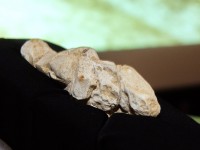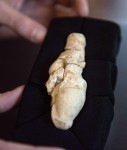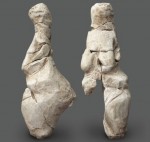 Archaeologists excavating the Renancourt neighborhood of Amiens in northern France have unearthed a small artifact of large historical significance. It’s a limestone statuette of a female figure with exaggerated breasts and buttocks of a type known as a Paleolithic Venus. She’s 23,000 years old, an artifact of the late Gravettian culture found in France and eastern Europe, reaching all the way to western Siberia. About a hundred Gravettian Venuses have been found all over Europe, including 15 examples in southwest France, but this is the first one discovered in the north of France. The last one unearthed in an archeological context in France was found in Tursac, Dordogne, in 1959.
Archaeologists excavating the Renancourt neighborhood of Amiens in northern France have unearthed a small artifact of large historical significance. It’s a limestone statuette of a female figure with exaggerated breasts and buttocks of a type known as a Paleolithic Venus. She’s 23,000 years old, an artifact of the late Gravettian culture found in France and eastern Europe, reaching all the way to western Siberia. About a hundred Gravettian Venuses have been found all over Europe, including 15 examples in southwest France, but this is the first one discovered in the north of France. The last one unearthed in an archeological context in France was found in Tursac, Dordogne, in 1959.
 In July of this year, the team was excavating a deposit of eolian silt from the end of the last glacial period (40,000 to 10,000 years ago), expecting to find relatively common Paleolithic remains like flints and animal bones. On the second day of the dig, they found a pile of limestone fragments that didn’t seem like natural chips. That night, they were able to puzzle together the 20 fragments to form an almost complete female statuette about 11 centimeters (4.3 inches) tall. Only the right leg piece is missing. It was carved from a single piece of limestone and archaeologists believe it shattered from the cold.
In July of this year, the team was excavating a deposit of eolian silt from the end of the last glacial period (40,000 to 10,000 years ago), expecting to find relatively common Paleolithic remains like flints and animal bones. On the second day of the dig, they found a pile of limestone fragments that didn’t seem like natural chips. That night, they were able to puzzle together the 20 fragments to form an almost complete female statuette about 11 centimeters (4.3 inches) tall. Only the right leg piece is missing. It was carved from a single piece of limestone and archaeologists believe it shattered from the cold.
 Typical of the 244 Upper Paleolithic Venuses that have been found from different periods in Europe (the oldest being the 35,000-40,000-year-old Venus of Schelklingen which is also the oldest known human figurative art), the secondary sex characteristics are unmistakably prominent, while the head and extremities are barely present. The Venus of Renancourt has a simple rounded shape for a head and roughly engraved arms and legs.
Typical of the 244 Upper Paleolithic Venuses that have been found from different periods in Europe (the oldest being the 35,000-40,000-year-old Venus of Schelklingen which is also the oldest known human figurative art), the secondary sex characteristics are unmistakably prominent, while the head and extremities are barely present. The Venus of Renancourt has a simple rounded shape for a head and roughly engraved arms and legs.
In a space of only nine square meters, archaeologists recovered an abundance of Paleolithic remains along with the Venus, including flint projectile points used for hunting and large blades used as tools like knives and scrapers. Numerous animal bones attest to horse meat having been on the menu regularly. Chalk jewelry — rounds pierced with a hole — discovered at the site is very unusual and may be unique to this deposit. The remains indicate this was a hunter’s camp which radiocarbon dating found to be 23,000 years old, the last phase of the Gravettian period.
It’s not just the Venuses that are rare discoveries in the north of France; evidence of Upper Paleolithic Cro-Magnon presence is rare because at that time there were still glaciers reaching all the way down to the modern-day Netherlands. This discovery suggests there was a window of warmer temperatures that allowed the Cro-Magnon hunters to travel north over impressively long distances. The Gravettian areas in the southwest of France are 125-185 miles away. That’s a lot of ground to cover on foot during an ice age.
The Venus of Renancourt will be studied thoroughly for the next few months before going on display at Museum of Picardie in Amiens.